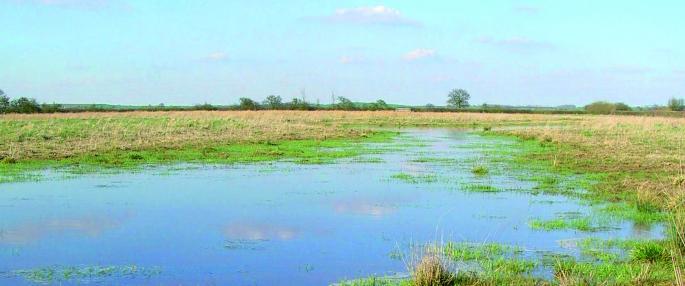
1. What is your job title/who is your employer?
I work as the Upper Ray Living Landscape Manager, with the Berkshire, Buckinghamshire and Oxfordshire Wildlife Trust (BBOWT). I manage an exciting 3-year Heritage Lottery Funded community and conservation project in the Upper Ray area on the Oxon/Bucks border. I am based at Meadow Farm: 29ha of species-rich grassland within the Upper Ray floodplain. This privately owned land, with distinctive ridge and furrow fields, had never been open to the public before, but since coming into our hands it has given nearly 2000 people the chance to find out about this wealth of heritage and wildlife through a diverse event programme, conservation work and infrastructure effort.
Many local people are involved in our work to protect it. Meadow Farm is also an integral part of our wider Upper Ray Reserves in the area – a landholding of over 170ha protected species-rich grassland and wetland habitat, supporting rare waders such as curlew and lapwing.
2. What is your typical working day/week?
As a project manager, my goal is to keep everything moving and the project on track, so my work patterns vary quite a bit. Between April and hay-cut in mid-July, you’ll often find me out in the ridge and furrow, leading guided walks, or brushing up on my wildflower ID. Our funded project finishes in 2017, so I am also tackling questions like how can we catch and demonstrate the impact of what we’re doing? And how are we going to build on this work beyond the life of the funding? I get the enviable task of summarising all the work the fantastic team have been up to, including many hundreds of volunteer hours to date!
3. Why did this type of work interest you?
I enjoy being able to shape and contribute to a large conservation project that actively embraces both biodiversity and people. Living Landscapes are still a growing area of work and while BBOWT has designated several Living Landscape project areas, our future work will be influenced by this philosophy and integrated more broadly into all our organisation’s delivery work, as well as driving funding to key project areas. It a diverse and evolving area of work - and I find that motivating.
4. What jobs and experience have led you to your present position?
My route to Living Landscapes has been varied. I gained a BA in Linguistics and English from Bangor University and was voted in as Sabbatical Welfare Officer for a year. I then took up a long-term voluntary placement with The Conservation Volunteers in Derbyshire. This experience, combined with my Sabbatical post, secured my first paid job in conservation back on home territory in Wales, working for RSPB Cymru. After the 3-year funding finished I worked as Eco-Schools Officer for a year, but wanted to get back into conservation and specifically targeted the Wildlife Trusts - knowing their commitment to community work and cohesive approaches to habitat management. In 2008 that led me to BBOWT - and I’m still here! Over the last 7 years I have worked in volunteer development, HR, as Community Wildlife Officer, membership recruiter, with school groups, managing staff and running a landowner liaison project. Two years ago I studied for a Diploma in Environmental Conservation with Oxford University, which consolidated more academically, the threads of my professional work and developed a stronger grounding in evidence-based approaches.
5. What part of this job do you personally find most satisfying? Most challenging?
In 2013 I led the Development Phase of this project and bringing it to life has been very rewarding: our first visiting schools, much-needed hedgerow management and welcoming people to these rare meadows. But, as for all of us in the sector, BBOWT does face challenges. BBOWT directly manages just a fraction of land in our three counties. We do this well, but biodiversity is still declining and we know that to make a real difference we must work more effectively at a landscape scale with agricultural and private landowners. This must include making better use of the resources we can offer (advice, kit, livestock) and getting to grips with the impacts and opportunities of the new Countryside Stewardship scheme. In the Ray over the last year or two we’ve provided green hay and brush harvested seed for over 40ha of grassland restoration on neighbouring private land. There is a way to go to find common ground, build trust and work more cohesively in the wider countryside.
6. Do you have any advice for someone interested in this field/job?
It’s an interesting time in conservation; the Ecosystems Service and Natural Capital agenda is growing and there is increasing pressure on politicians to act on the evidence that nature is an essential part of our physical and psychological wellbeing. These important factors will impact conservation organisations far more in the near future, so keep abreast of the politics and debates. BBOWT appointed an Ecosystem Services Policy Analyst this year and other Trusts are looking into better understanding the ‘value’ of biodiversity, and ways of engaging with the health agenda, so there could be some interesting new opportunities in the sector.
Organisations like the Wildlife Trusts thrive because we have a mix of skills within our staff teams: those with lifelong time in the conservation sector working alongside those career changers– those from law, accountancy, teaching, IT and project management to name a few.
Follow your passion; play to your strengths but don’t be afraid to take on something new! And always keep an eye out for opportunities to learn, wherever you find it; so far this autumn I have tried my hand at mammal trapping and just this week learnt to ID bat poo!
To find out more visit:
(links open in a new tab)
